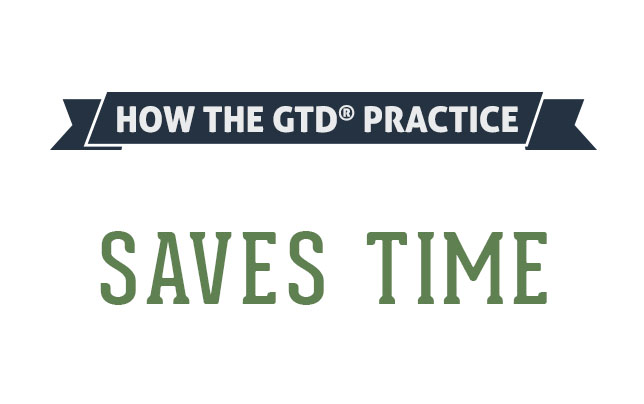What’s holding you back from fully committing to Getting Things Done®?
For busy creatives, it is the excuse – “I don’t have the time!”
You’re probably doing well in life. Stuff is being processed. You are not on the verge of collapse.
So why invest precious seconds in a framework that sounds like a lot of thinking and a lot of organizing?
Will it make a significant impact on what you do and how much you do?
The Most Important Thing You Need to Know About GTD®:
Getting Things Done is not about cramming more into your already crammed plate.
Instead, it is a practice of regularly clearing that plate and only taking on that which gets you measurably closer to the goals which truly matter.
When you get to a place where you are confidently saying “no” to everything that doesn’t belong on your plate, you automatically have more time for the projects and dreams that have been on the back-burner.
5 Ways in Which the GTD® Steps Save Time & Make Your Life More Rewarding:
Here’s a shocker.
Even if you don’t practice Getting Things Done® you do a jumbled, worst practice take on all the 5 steps of the methodology – Capture, Clarify, Organize, Reflect and Engage. I’ll discuss that in a minute.
Formally getting onboard the GTD® train means you choose the best way to execute a step, instead of defaulting to the latest and loudest.
Step 1: Capture:
You’re already doing Capture. You’re probably capturing things in your mind that you need to do something about. Like: Taxes, birthday party, follow up with client etc.
But your mind is a very poor to keep a track of your commitments.
So instead of the worst practice of capture, use the best practice: Capture things outside your mind, in a place that you trust you will get back to.
Step 2: Clarify
Clarify talks about using the GTD® algorithm to decide what’s actionable, what’s not and what is the possible Next Action that you can take for progress on projects.
Guess what? You’re already clarifying. In fact without deciding on the Next Action, you can’t really move forward.
But instead of deciding when there is an emergency (which is the worst practice), make the decision upfront.
Step 3: Organize
Organize is the step where you put what you’ve clarified in clear categories. In other words, you create contextualized Next Action lists for different settings of your life so that you can do the right things at the right time!
For example:
All your Next Actions that happen at home at parked in an @Home List
All your Next Actions that happen in front of your computer at parked in an @Computer List
You’re already doing “organize” in some form or the other right now. For example, you may have a list of things that capture your attention. Or you’ve got a bunch of papers on your desk, or in your drawers. But they may not be organized in clear categories.
So instead of placing things in unclear stacks, follow the best practice of organizing them in clear categories.
Step 4: Reflect
This step is about reviewing your lists regularly. At least once a day review your Next Action lists. And once a week review your entire system, to ensure it’s up to date.
By not doing reflect, you’ll have no choice but to react to the latest and loudest.
So instead, take a look at your commitments,
Step 5: Engage
This step is about making a trusted choice about what to do at any given moment. Read more about Engage.
Everyone, including you, is getting work done.
But are you making the right choice moment to moment?
Do you have a feeling of control over your commitments?
Are your actions aligned with your higher purpose?
In other words, are you able to get things done without the stress?
If you follow the first 4 steps, the answer to the questions is yes.
So instead of Getting Things Done with a lot of stress.
All we’re suggesting is use the 5 steps so that you can get things done, stress-free! 🙂
I believe our work should be an expression of our most creative selves. I work with business owners and their teams to achieve stress-free productivity.

